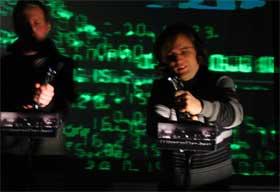 As i mentioned earlier, dorkbot Berlin was really good fun. Nice crowd, absence of delays, and talented dorkboters. In order of appearance:
As i mentioned earlier, dorkbot Berlin was really good fun. Nice crowd, absence of delays, and talented dorkboters. In order of appearance:
The c-base gang presented their multi-touch console (MTC), a touch-sensitive and programmable camera/projector table interface that reacts to more than one touch. They explained how they were inspired by Jeff Han‘s multi-touch screens. However their MTC features a few bonuses: it is “designed to survive c-base” and thus shouldn’t be afraid of having bottles of beers dropped upon it; it is (sort of) affordable because they built it with their own pocket money; It is mobile, there’s no external part and it’s OS so you can make your own.
Simon Schiessl presented the installation Mechanism-#1-War he developed together with Saoirse Higgins. I first felt like boo-boo-ing him for reading his notes but his work was fascinating enough to captivate the audience. In a few words: you wind up a mechanical drummer boy with the brass key. The action of the toy correlates to a projected video that shows bombs dropping from the sky in real time. The sound of the bombs keeps exact beat with the drum. I was surprised to learn that they decided not to use images of contemporary bombs or missiles because they look too much like toys so they used WWII footage instead.

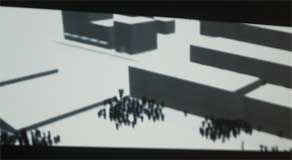
He also presented the second version of Mechanism of War. Emergency is a video projection that examines traffic as situation of mass panic triggered by a gobal impact. Visitors crank a mechanical siren. The sound rises and triggers a simulation of a human crowd trying to escape. Hundreds of virtual people, alarmed by the siren, run away in all directions on a 360 degree surround image. Each simulated person is controlled by artificial intelligence aimed to represent realistic people-people and people-alarm behaviour in evacuation trials.
The software is used by experts to predict the consequences of the movement – whether people live or die. In some ways the software is used as a reassuring influence on the architects and designers who build future complex systems but is it really possible to control and understand something which is inherently difficult to predict as it involves so many loose parts? Animation movie.
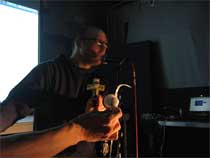
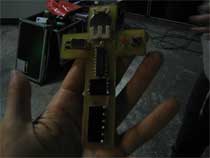 Elliott Malkin presented his famous Crucifix NG (Next Generation), a wall-mountable device that broadcasts an ASCII, non-denominational version of the Lord’s Prayer at 916 megahertz. He also talked about Jewish architectural codes and how his projects (such as Modern Orthodox) revisits religious traditions with the help of digital technologies.
Elliott Malkin presented his famous Crucifix NG (Next Generation), a wall-mountable device that broadcasts an ASCII, non-denominational version of the Lord’s Prayer at 916 megahertz. He also talked about Jewish architectural codes and how his projects (such as Modern Orthodox) revisits religious traditions with the help of digital technologies.
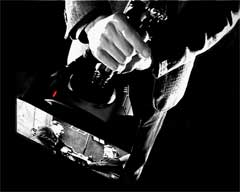 The best surprise of the show was the (((controller-beat performance. The two musicians produced what they call “Joysticks club music.” There are videos on their website but i’ll try to upload mine later on today (just need to get a better net connection.)
The best surprise of the show was the (((controller-beat performance. The two musicians produced what they call “Joysticks club music.” There are videos on their website but i’ll try to upload mine later on today (just need to get a better net connection.)
A few images from the evening. But Fabienne has the coolest images so i stole one of them for this post.
